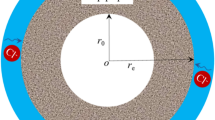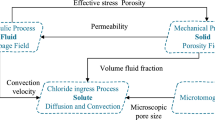Abstract
Chloride penetration into reinforced concrete (RC) hollow cylinder piles has been identified as one of major factors to cause corrosion of reinforcing steel and to affect the performance and serviceability of piles. Chloride penetration into unsaturated RC hollow cylinder piles in marine tidal zones involves the coupling of diffusion and convection mechanisms. The goal of this study is to investigate the chloride diffusion-convection behavior into unsaturated RC hollow cylinder piles in marine tidal zones through numerical modeling. The governing equation to model the chloride diffusion-convection mechanism was derived and solved numerically using the finite difference method. An illustrative example was demonstrated to predict the chloride concentration distributions in unsaturated RC hollow cylinder piles in the marine tidal zones. Parametric analysis was performed to examine the influence of the main parameters on the chloride concentration distributions in unsaturated RC hollow cylinder piles. The analysis results indicated that the convection action had an obvious effect on the chloride penetration in the convection zone. Chloride diffusion-convection resulted in an increase in the chloride concentration, and the increase in the convection zone was more significant compared to that in the steady diffusion zone at a fixed exposure depth. The influence of the convection zone depth on the chloride concentration distributions was not as significant as the effects of chloride diffusion coefficient and convection velocity in unsaturated RC hollow cylinder piles.










Similar content being viewed by others
References
Ababneh A, Benboudjema F, Xi Y (2003) Chloride penetration in nonsaturated concrete. J Mater Civ Eng 15(2):183–191
Bastidas-Arteaga E, Chateauneuf A, Sanchez-Silva M, Bressolette P, Schoefs F (2011) A comprehensive probabilistic model of chloride ingress in unsaturated concrete. Eng Struct 33(3):720–730
da Costa A, Fenaux M, Fernandez J, Sanchez E, Moragues A (2013) Modelling of chloride penetration into non-saturated concrete: case study application for real marine offshore structures. Constr Build Mater 43:217–224
Gao YH, Zhang JZ, Zhang S, Zhang YR (2017) Probability distribution of convection zone depth of chloride in concrete in a marine tidal environment. Constr Build Mater 140:85–495
Homan L, Ababneh AN, Xi YP (2016) The effect of moisture transport on chloride penetration in concrete. Constr Build Mater 125:1189–1195
Khatri RP, Sirivivatnanon V (2004) Characteristic service life for concrete exposed to marine environments. Cem Concr Res 34(5):745–752
Lei MF, Peng LM, Shi CH (2014) An experimental study on durability of shield segments under load and chloride environment coupling effect. Tunn Undergr Space Technol 42:15–24
Lin G, Liu YH, Xiang ZH (2010) Numerical modeling for predicting service life of reinforced concrete structures exposed to chloride environments. Cem Concr Compos 32(8):571–579
Liu P, Yu ZW, Lu ZH, Chen Y, Liu XJ (2016) Predictive convection zone depth of chloride in concrete under chloride environment. Cem Concr Compos 72:257–267
Lu ZH, Zhao YG, Yu ZW, Ding FX (2011) Probabilistic evaluation of initiation time in RC bridge beams with load-induced cracks exposed to de-icing salts. Cem Concr Res 41:365–372
Marchand J, Samson E (2009) Predicting the service-life of concrete structures–limitations of simplified models. Cem Concr Compos 31(8):515–521
Meijers SJH, Bijen JMJM, Borst RD, Fraaij ALA (2005) Computational results of a model for chloride ingress in concrete including convection, drying-wetting cycles and carbonation. Mater Struct 38(2):145–154
Nielsen EP, Geiker MR (2003) Chloride diffusion in partially saturated cementitious material. Cem Concr Res 33(1):133–138
Pang L, Li QW (2016) Service life prediction of RC structures in marine environment using long term chloride ingress data: comparison between exposure trials and real structure surveys. Constr Build Mater 113:979–987
Rincon OT, Castro P, Moreno EI, Torres-Acosta AA, Bravo OM, Arrieta I, Garcia C, Garcia D, Martinez-Madrid M (2004) Chloride profiles in two marine structures-meaning and some predictions. Build Environ 39:1065–1070
Saetta AV, Scotta RV, Vitaliani RV (1993) Analysis of chloride diffusion into partially saturated concrete. ACI Mater J 90(5):441–451
Shao W, Li JP (2014) Service life prediction of cracked RC pipe piles exposed to marine environments. Constr Build Mater 64:301–307
Song HW, Shim HB, Petcherdchoo A, Park SK (2009) Service life prediction of repaired concrete structures under chloride environment using finite difference method. Cement Concr Compos 31(2):120–127
Wang YZ, Wu LJ, Wang YC, Li QM, Xiao Z (2018) Prediction model of long-term chloride diffusion into plain concrete considering the effect of the heterogeneity of materials exposed to marine tidal zone. Constr Build Mater 159:297–315
Ye HL, Jin NG, Jin XY, Fu CQ (2012) Model of chloride penetration into cracked concrete subject to drying-wetting cycles. Constr Build Mater 36:259–269
Zhang Y, Zhang MZ (2014) Transport properties in unsaturated cement-based materials-A review. Constr Build Mater 72:367–379
Acknowledgements
This research was financially supported by the National Natural Science Foundation of China (Grant Nos. 51609135 and 41772273) and the State Key Laboratory of Coastal and Offshore Engineering (Dalian University of Technology) (Grant No. LP1819).
Author information
Authors and Affiliations
Corresponding author
Additional information
Publisher's Note
Springer Nature remains neutral with regard to jurisdictional claims in published maps and institutional affiliations.
Rights and permissions
About this article
Cite this article
Shao, W., Shi, D. & Li, L. Chloride Diffusion-Convection into Unsaturated RC Hollow Cylinder Piles in Marine Tidal Zones. Geotech Geol Eng 37, 2781–2789 (2019). https://doi.org/10.1007/s10706-018-00793-x
Received:
Accepted:
Published:
Issue Date:
DOI: https://doi.org/10.1007/s10706-018-00793-x




